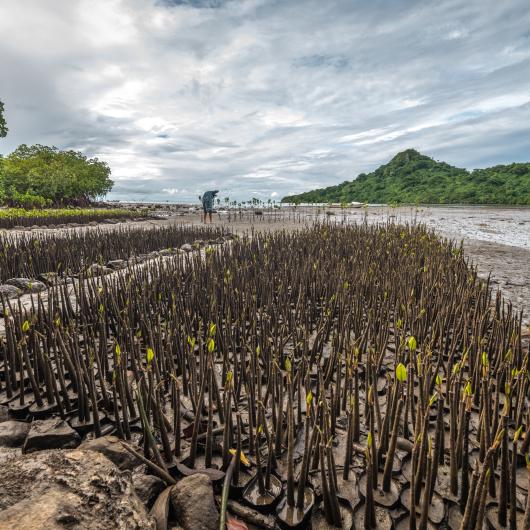Mangrove Risk Index
Recent research from Switzerland and the United States has developed a comprehensive risk index for mangroves. This index evaluates the impact of climate threats such as rising sea levels and increasing tropical cyclones on mangrove ecosystems globally. Published in April 2025, the study aims to guide future conservation efforts for these vital coastal ecosystems.
About Mangrove Ecosystems
Mangroves are coastal trees that thrive in salty environments. They provide essential services, including coastal protection, carbon storage, and support for fisheries. These ecosystems are crucial for biodiversity and local economies. However, they face threats from climate change.
The Risk Index Explained
The newly developed risk index assesses mangrove vulnerability under three future scenarios known as Shared Socioeconomic Pathways (SSPs). These scenarios range from moderate emissions (SSP2-4.5) to very high emissions (SSP5-8.5). The index indicates that over 56% of the world’s mangroves could face high or severe risk by 2100, particularly under the worst-case scenario.
Impact of Climate Change
Mangroves can adapt to small changes but struggle with severe climate impacts. Rising sea levels and stronger storms create conditions that may lead to regime shifts. This term refers to irreversible changes in ecosystem structure and function. For example, under the SSP3-7.0 scenario, 52% of mangroves could be at high risk, which threatens their ability to provide essential services.
Consequences of Mangrove Loss
The loss of mangroves can have dire consequences. They protect coastlines from storm waves, store amounts of carbon, and provide habitat for fish. If mangroves are destroyed, carbon is released into the atmosphere, exacerbating climate change. Additionally, the decline in fish populations can threaten food security and livelihoods for millions.
Global Hotspots of Risk
Certain regions are identified as global risk hotspots. The Caribbean and Central America are particularly vulnerable due to expected increases in storm intensity. South and Southeast Asia, with their extensive mangrove forests, face threats from rising sea levels. Eastern Africa is also at risk, especially with low-lying land areas.
Strategies for Conservation
To mitigate risks, researchers recommend several strategies. These include restoring mangroves in safer areas, using engineering to enhance growth, and mixing species to improve resilience. It is crucial to integrate climate risks into conservation planning and funding for mangrove projects. Future studies should also consider the effects of marine heatwaves and droughts.
Socioeconomic Implications
Around 775 million people rely on coastal ecosystems for their livelihoods. Mangroves alone provide approximately $65 billion annually in flood protection. However, current climate damage discussions often overlook the economic losses associated with mangrove degradation. Protecting these ecosystems is essential not only for biodiversity but also for human well-being.
Month: Current Affairs - April, 2025
Category: Environment Current Affairs








